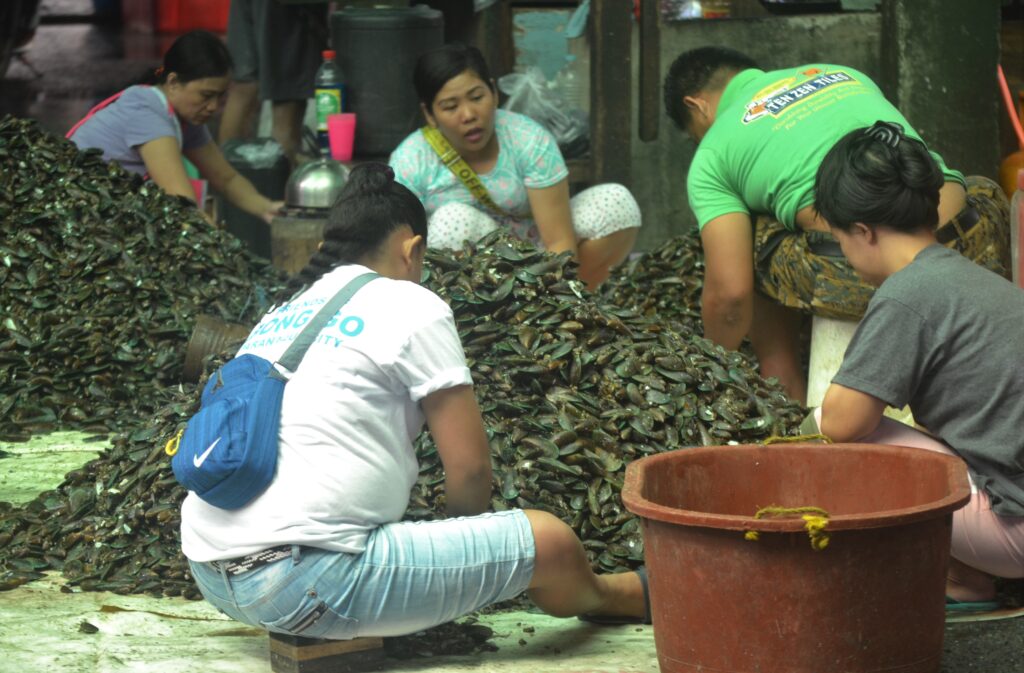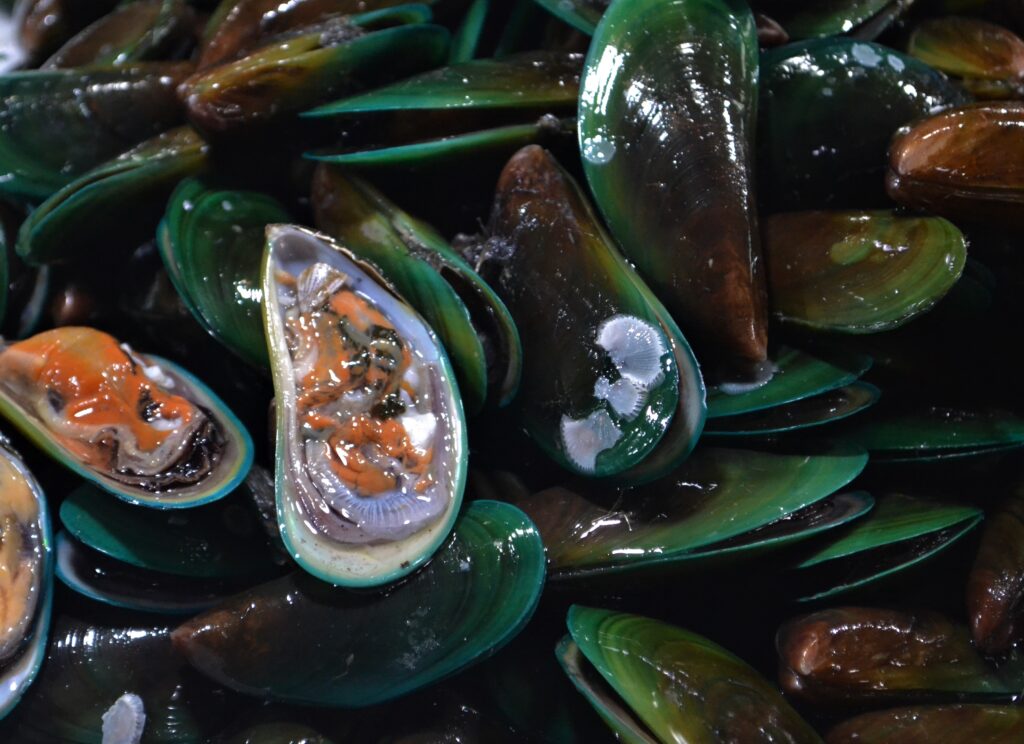Text and Photos by Henrylito D. Tacio
Mussels have been eaten by human beings since time immemorial. But a project funded by the Department of Science and Technology – Philippine Council for Agriculture, Aquatic and Natural Resources Research and Development (DOST-PCAARRD) has discovered that mussels can also be turned into patis, too.
Generally, patis is made from fish which is why it is called fish sauce in English. The study led by Dr. Ernesta M. Peralta of the Institute of Fish Processing Technology of the University of the Philippines Visayas (UPV) showed that green mussels could also be fermented and made into patis.
Just like the traditional fish patis, the low-salt fermented mussel sauce can be used to add flavor to soups, broths, and dishes, as well as a sawsawan or dipping sauce. Unlike the fish patis, it has the potential of being a functional food and food ingredient.
Functional foods, also known as nutraceuticals, are ingredients that offer health benefits that extend beyond their nutritional value. Nutrient-rich ingredients like fruits, vegetables, nuts, and seeds are often considered functional foods as well.
Due to changing lifestyles and increasing demand for healthier food and food ingredients, Dr. Peralta developed patis tahong – as it is called – from green mussels, known in the science world as Perna viridis.
The green-shelled bivalves are locally known as tahong. They are abundantly found in the country and an important farming commodity in many coastal areas.
The Food and Nutrition Research Institute (FNRI), a DOST line agency, says mussels are nutritionally rich. They contain 13.6% protein, 11.1% carbohydrates, and 7.5% fats. They are also a good source of calcium, phosphorus, iron, thiamin, riboflavin, foliate, vitamin B12, manganese, selenium, omega 3 and 6, magnesium, potassium, and zinc.
“Aside from being low in salt, patis tahong is all-natural and has no artificial color, preservatives, and monosodium glutamate (MSG),” said a press statement.
Healthy
In a consumer acceptability testing conducted, the product elicited positive responses for its odor, taste, and consumers’ willingness to buy. The low-salt mussel fermented sauce, as such, has market potential due to its product attributes.
The development of patis tahong also addresses a specific market niche requiring low-salt seasoning but superior to industrially produced fish sauce. “It has a promising competitive edge or at par with premium fish sauce brands,” the statement said.

Mussel preparation for dispatch 
Green mussels for sale
Mussel production in the Philippines has remained stagnant over the years. It first appeared in Philippine fisheries statistics only in 1971 when 38 metric tons were reported. In fact, mussels were then considered a pest.
“Mussels were initially considered as a fouling organism by oyster growers,” Simeone M. Aypa wrote in a paper published by the UN Food and Agriculture Organization (FAO). “The impetus for mussel culture in Manila Bay came about when oyster growers, attempting to collect oyster spats in less silty offshore waters, instead obtained exceptionally heavy and almost pure mussel seedlings.”
Mussel farming
Since then, mussel culture has gone a long, long way. “Mussel farming does not require highly sophisticated techniques compared to other aquaculture technologies,” Aypa wrote. “Even unskilled laborers, men, women, and minors can be employed in the preparation of spat collectors as well as harvesting. Locally available materials can be used. The mussel harvest can be marketed locally and with good prospects for export.”
Being an archipelago, the Philippines has high potentials for expanding its mussel farming area and increasing its production level significantly. In the early 1980s, the FAO identified 4,925 hectares of potential expansion sites in Samar, Quezon, Aklan, and Capiz, among others.
Only green mussels are farmed in the country. The brown mussels are not suitable for farming because they are not known to attach to ropes or bamboo poles but only to living adults growing in dense mats on muddy bottoms.
Mussel farms are mainly found in Bacoor and Manila Bays in Luzon as well as in Sapian Bay in West Visayas, Maqueda Bay in East Visayas, and in a number of bays and inlets along the northern coast of Panay Island.
“This bivalve species reaches sexual maturity within the first year and spawns with the rising of seawater temperature,” Aypa wrote. “In the Philippines, mussels spawns year-round, however, the peak period of spawning and setting is in April and May and again in September to October. Eggs and sperms are shed separately and fertilization occurs in the water.”
Life-cycle
According to Aypa, green mussels have two relatively distinct phases in their life-cycle. “A free-swimming planktonic or larval stage and a sessile adult stage. The free-swimming larva remains planktonic for 7-15 days, depending on the water temperature, food supply, and availability of settling materials.
“At about 2-5 weeks old, the larvae seek a suitable substrate to settle on and final metamorphosis takes place, changing its internal organ structure to the adult form. The young spat then grow rapidly and within 4-8 weeks, after settlement they measure 3-4 millimeters in shell length,” Aypa wrote.
The mussel industry is an important component of the aquaculture sector in the country. Due to its popularity in recent years, mussel farming now provides additional income and livelihood to fisherfolk in many coastal areas.
As it requires little capital, fisherfolk can readily raise mussels.
Longline system
There are many ways of growing mussels, but Filipino marine scientists are recommending the use of the longline system of mussel growing.
A kind of hanging method, it is different from the stake method, the traditional way of culturing the young mussels (spats) in bamboo stakes or poles.
“In this method, the bamboo poles act as a wall or barrier to the runoff from the uplands resulting in siltation,” explained Rodolfo De Guzman of the Science and Technology Information Institute (STII) of the Department of Science and Technology (DOST). “In time, the accumulated silt makes the waters shallow and is no longer suitable for mussel culture.”
In the longline method, the young mussels are literally hanging on the line that is submerged in the water. This is the reason why it is sometimes called sampayan, the Filipino term for a clothesline.
“The cost of the longline is much lower than the stake method that uses bamboo, which is more expensive,” De Guzman wrote.
The longline culture system is already practiced in New Zealand, but the local counterpart is a cheaper version. The Philippine version is modified by PCAARRD.
Aside from being inexpensive, the longline method is easy to manage and maintain. The spats are collected from the wild using spat collectors made of coconut husks, which are generally thrown away.
Here’s how it is done: The collected young mussels are placed in onion bags and then hung in 50-meter longlines with recycled plastic containers that serve as floats. All the fisherfolk need to do is regularly clean the longline of unwanted materials which come from the water and attach themselves to the lines.
After four to six months, the mussels are ready for harvest.
“Based on research, the longline method is a viable economic enterprise with a return on investment rate of as high as 87% and a short payback period of just one year to recoup investment,” De Guzman wrote.
Some notes
As most materials used are recycled, the longline method is considered environment-friendly. In addition, it is also climate-resilient as “it is not easily destroyed during typhoons and other natural calamities.”
During typhoon advisories, fisherfolk are advised to fill the plastic containers with seawater so that “the longline can be lowered, thus preventing it from being damaged by big waves or strong winds,” said Dr. Carlos Baylon, a professor at the University of the Philippines-Iloilo, who was the project leader of the Pinoy Longline Mussel Farming System.
Another way is to untie the longline from the concrete anchor and move to a sheltered area until the typhoon has passed through the culture site, Dr. Baylon added.
The longline method can also be employed in deeper waters. Unlike the stake method, it won’t cause sedimentation, and most importantly, it reduces damage to the coastal environment. With all these advantages, the longline method is described as “a sustainable enterprise.”
Despite this, the production of mussels is still not as vibrant compared to other aquaculture initiatives. Part of the problem is the insufficient and unstable seed stock. Spat supply is affected by both human activities and nature.
“The mussel industry in the Philippines is still dependent on collection of wild spats,” Dr. Baylon was quoted by Hatchery International. “The supply from the wild should be supported by production from the hatchery.”
In 2014, the UP-Visayas launched the Mussel Hatchery and Nursery Program with funding support from DOST.
Based on the study, the hatchery-produced green mussel spats that were transported to different culture sites as far as 1,250 kilometers away from the site “attained high survival of up to 100 percent.”
Food preparation
Mussels are prepared differently, according to Wikipedia. In Belgium, the Netherlands, and France, mussels are consumed with French fries or bread. In Italy, mussels are mixed with other seafood; they are consumed, often steam cooked, sometimes with white wine, herbs and served with the remaining water and some lemon.
In Ireland, mussels are boiled and seasoned with vinegar, and boiling water is used as a supplementary hot drink. In New Zealand, they are served in a hot pepper- or garlic-based vinaigrette, processed into fritters and fried, or used as the base for a chowder.
In Brazil, it is common to see mussels being cooked and served with olive oil, usually accompanied by onion, garlic, and other herbs. In India, mussels are either prepared with drumsticks, breadfruit, or other vegetables or filled with rice and coconut paste with spices and served hot.
Warning
People who love to eat mussels must ensure that the mussels they are cooking are alive before being cooked. The enzymes mussels produce quickly break down the meat and make them unpalatable or poisonous after dying or uncooked. Some mussels might contain toxins, the Medline Plus Encyclopedia warns.
“A simple criterion is that live mussels, when in the air, will shut tightly when disturbed,” the ABC Science pointed out. “Open, unresponsive mussels are dead, and must be discarded. Unusually heavy, wild-caught, closed mussels may be discarded as they may contain only mud or sand. A thorough rinse in water and removal of ‘the beard’ is suggested.”
In addition, don’t eat mussels that are harvested in areas where there is red tide. It is caused by dinoflagellates, and their toxins are harmless to mussels. But if the mussels are eaten by humans, the concentrated toxins can cause serious illnesses like paralytic shellfish poisoning.

